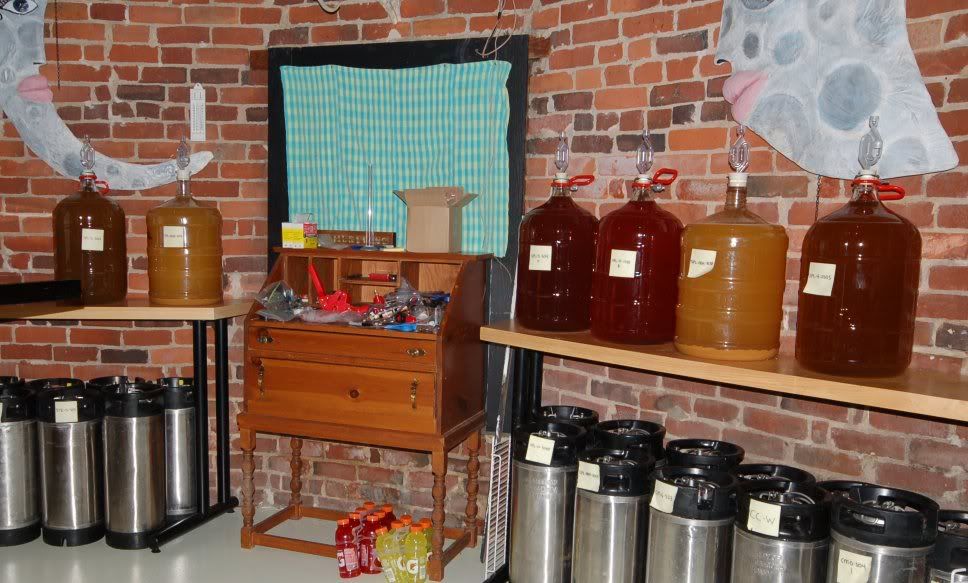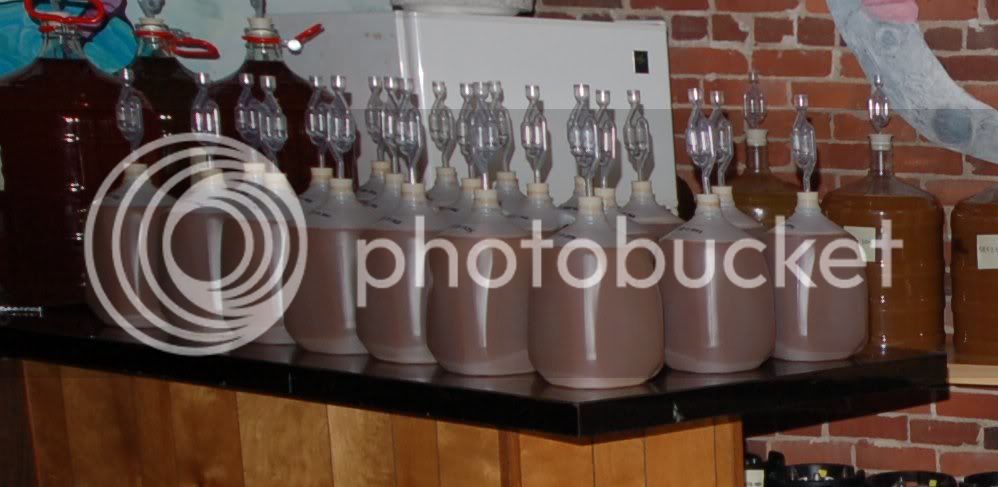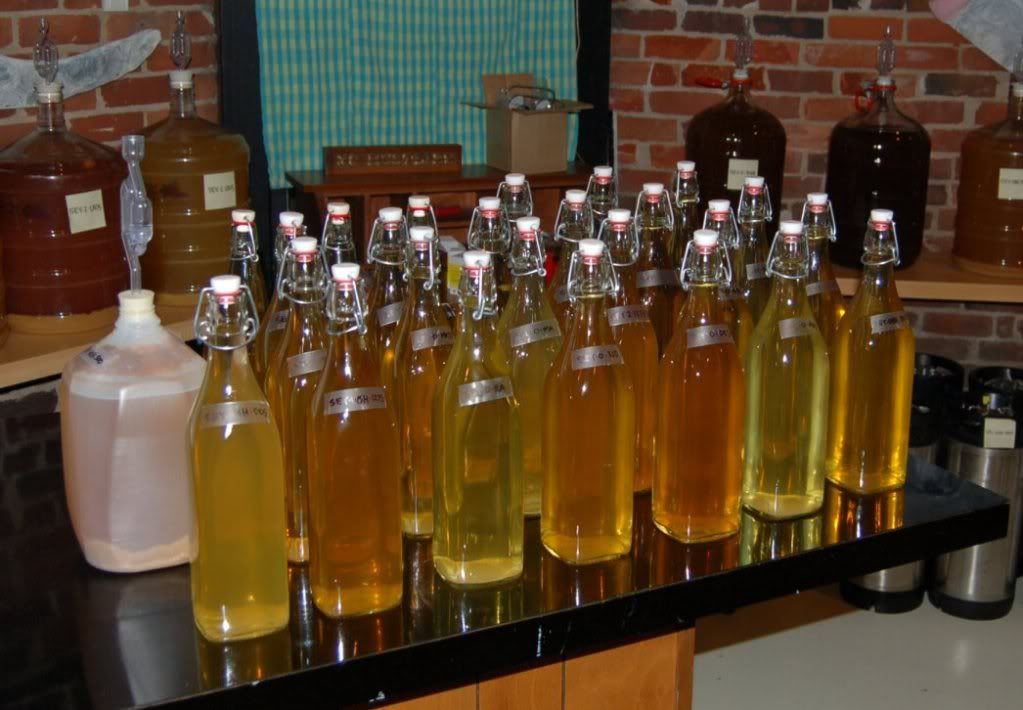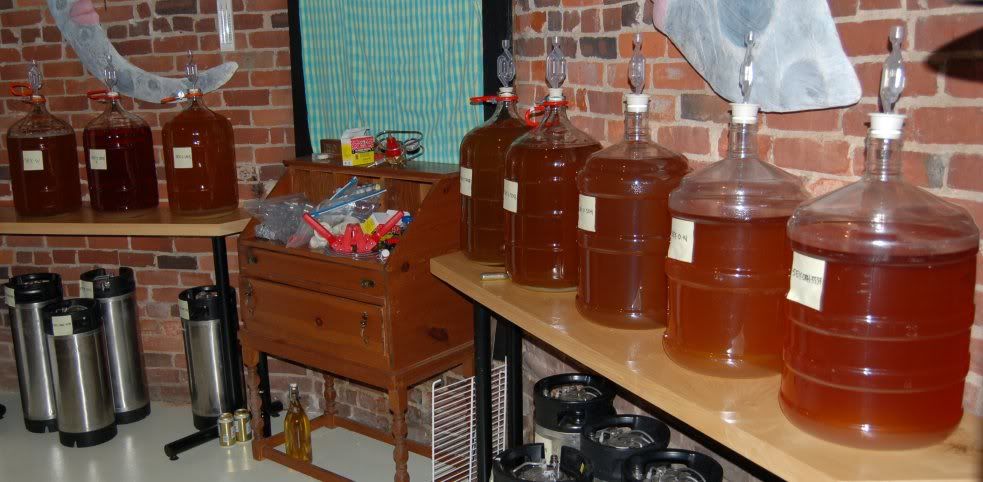Last Wednesday some friends came over to help evaluate the latest experimental batches. We checked out a couple of previous favorites and then 21 new ciders. Eighteen folks were kind enough fill out rating sheets and I got some great feedback. Three months in the bottle was real good for the UK yeasts (as well as Morgans, which is from Beenleigh, Australia, via a UK store). They all got noticeably better from the last time I tasted them.
The 3333 batch from October picked up a secondary fermentation. It didn’t break the bottle, but it had a strong carb and tasted like it had dropped at least 4 points in the bottle. It was the first one we tasted. All the other bottles were either completely still or a very tiny bit of carbonation, having been bottled from 2 weeks to almost 6 months ago. I put all the rest of my 3333 bottles in the fridge just in case this is a problem with that yeast not staying stable after the crash.
The ciders were mostly from the last two pressings and three from an earlier pressing:
Jan 13th 2009: 50:% Stayman, 25% York and 25% Empire. OG 1.066 Bottled March 2010
Nov 24th 2009: 50% Stayman and 50% Pink Lady.. OG 1.060. Bottled Dec 2009
Oct 8th 2009: 50% Stayman, 25% York and 25% Empire. OG 1.054 Bottled October 2009
Here are the ciders with average score ( rated 1-10, with 10 highest) and [overall ranking] for the top batches
rank rating Pressing Yeast Additives? final gravity
(6.36) - SYE 10-8-09 Wyeast 3333 Bavarian Wheat yeast no sugar 1.010
(3.14) - SYE 1-13-10 Wyeast 1275: Thames Valley Ale turbinado 1.000
(7.04) - SYE 1-13-10 Wyeast 005 British Ale yeast 3oz sage honey 1.008
(6.39) - SYE 1-13-10 White Labs 500 Trappist Ale Yeast turbinado 1.012
(6.32) - SYE 10-8-09 White Labs 380 Hefeweizen yeast no sugar 1.010
(4.62) - SPL 11-24-09 Enoferm Assmanhaussen wine yeast no sugar 1.005
[9] (7.37) - SPL 11-24-09 Youngs Ale yeast no sugar 1.010
(4.57) - SYE 1-13-10 Wyeast 1275: Thames Valley Ale no sugar 1.000
[5] (7.70) - SYE 10-8-09 Wyeast 3056 Bavarian blend yeast, turbinado 1.012
[7] (7.65) - SPL 11-24-09 Morgan Ale Yeast no sugar 1.008
[8] (7.43) - SYE 1-13-10 White Labs 320 Hefeweizen yeast orange blossom honey 1.004
(6.67) - SPL 11-24-09 Gervin English Ale yeast no sugar 1.008
(6.08) - SYE 1-13-10 White Labs 500 Trappist Ale Yeast no sugar 1.002
[10] (7.36) - SYE 1-13-10 Wyeast 005 British Ale yeast 2.25oz turbinado 1.012
(5.93) - SPL 11-24-09 Lalvin RHST wine yeast no sugar 1.000
[4] (7.86) - SPL 11-24-09 Youngs Lager yeast no sugar 1.010
(6.75) - SYE 1-13-10 White Labs 320 Hefeweizen yeast no sugar 1.002
[2] (8.00) - SPL 11-24-09 Brupaks Ale yeast no sugar 1.012
[6] (7.67) - SPL 11-24-09 Ritchies Real lager yeast no sugar 1.012
[1] (8.25) - SYE 1-13-10 White Labs 005 British Ale yeast no sugar 1.010
[3] (8.00) - SPL 11-24-09 Ritchies Real ale yeast no sugar 1.010
Take those last couple scores with a grain of salt, as these were the last ciders of the evening, although the WLP005 was very good as was the Brupaks. I see multiple kegs of those two for next season. I thought the Gervins, Youngs Ale and Ritchies Lager were all at least as good as the Ritchies Ale. The Wyeast 3056 makes a great sweet cider. I liked the WLP500 a lot, but not too many agreed with me. Same with the Wyeast 1275 and RHST, both of which make a decent dry cider. Overall, dry ciders don’t get much love, although some people like them a lot and find the other stuff too sweet. The driest of the top 10 ciders was the Morgan Ale at 1.008. That one had a nice sour apple finish.
Right now, what I like the most about the Brupaks, Gervins, Morgan, Ritichie and Young yeasts is that they are all dry yeasts and I have an extra packet of each in my fridge for next season. They have mostly Fall 2011 expiration dates. Hopefully before I run out of these, someone will start distributing them in the US.








